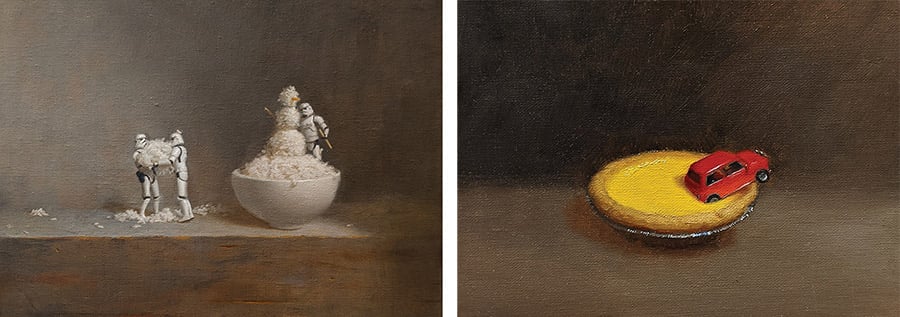
Let it Rice, Let it Rice, Let it Rice and Stuck in an Egg Tart, paintings by Chang Ya Chin, whose work is on view this month with Half Gallery at Art Basel Miami © The artist. Courtesy Half Gallery, New York City
Astronomers created a detailed map of all the stars ever to have died in the Milky Way. A report of stars in the sky during the solar eclipse of July 19, 418, at Constantinople allowed Japanese astronomers to remap the path of totality. The sarcophagus of Ptahemwia, treasurer to Ramesses II, was found inscribed with emblems to Nut, who was likewise found in art uncovered at the temple of Esna, which also depicts the gods of the sun and the moon in the other world. Fifteen falcons, most of them headless, were found buried in a temple at Berenike along with a stele whose inscription reads it is improper to boil a head in here. Confusion over a hapax legomenon in an Old Hungarian runic inscription led to its being misread as i love you sexually enik?, my enik? rather than as i love you enik?, my enik?! In the Liang Tebo cave in Borneo, archaeologists found evidence of the earliest survived amputation, from 31,000 years ago. Violent deaths were more common than previously thought among South American mummies. Underweight and normal weight human bodies, but not overweight ones, increase the bacterial diversity of the soil in which they decompose.
Shock collars can compel grazing cattle to create firebreaks in the scrublands of the American West. The Great Salt Lake is becoming saltier. Physicists described the salinity staircase of the Arctic Ocean, where glass microspheres will only further melt sea ice, and where the number of rainy days is predicted to double by 2100. Refreezing the poles was estimated to be possible at an annual cost of $11 billion, while the net economic benefit of decarbonizing the world’s energy grids by 2050 was estimated to be $12 trillion. Cleaner air is reducing the warming-mitigation effect of air pollution. A study of leaf temperatures determined that atmospheric warming will compromise the carbon uptake of forests. Hateful tweets in the United States increase by up to 22 percent when temperatures rise above seventy degrees Fahrenheit, and a temperature-racist-tweet response curve was discovered in Europe. The largest organism on earth is beginning to break apart.
Blue whales can tell when the wind is changing. A new species of octopus was discovered at the Dongshan Seafood Market Pier. The California two-spot octopus always attacks using its second arm on either side. Marine biologists described the strange attractor of narwhals’ apparent diurnal chaos. Declines in amphibian populations may be tied to malaria outbreaks among humans, zoo bears are being fed too much protein, and a two-decade observation of apes found evidence of enduring relationships between gorillas and chimpanzees. Hotel guests prefer female robots. Cornell computers anticipated the moves of volleyball players with 80 percent accuracy. The consciousness of ICU patients can be tracked algorithmically, and music may temper the delirium of elderly, mechanically ventilated ICU patients. Wakeful mind-blanking is structurally similar to deep sleep. Chemists were close to completing a marijuana breathalyzer. The lead author of a study on toxoplasmosis infections in humans explained that “the most ‘sexy’ takeaway from our study is that our political views are also shaped by biological factors, including parasitic infections,” which were recently found to make humans sexier. Dehorning black rhinos does not hurt their sexual prospects. The pandemic led to a shortfall of three million American pet neuterings. Dogs can smell the lingering presence of stress. A green puppy was born on a lavender farm.






















































































